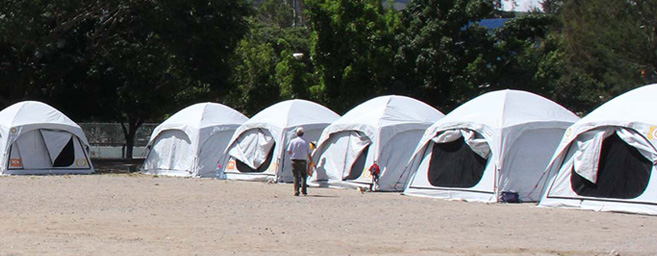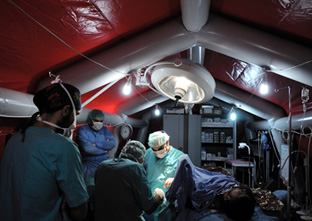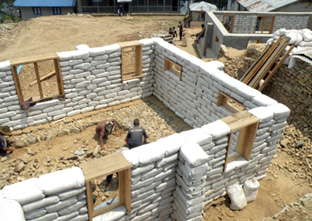
Plastics provide a roof for the homeless
Code red for emergency shelters
The first thing any victim of a natural disaster, or of conflict, needs is shelter. Providing emergency shelter is among the main priorities of most humanitarian operations. The High Commission for Refugees (UNHCR) alone, has a quasi-permanent inventory of 50,000 family tents in its three centres in Dubai, Copenhagen and Durban. Along with the International Federation of Red Cross and Red Crescent Societies (IFRC) and the International Committee of the Red Cross (ICRC), this UN agency has greatly contributed to standardising the emergency shelters distributed in camps. Their efforts helped to make family tents the norm. Each tent provides five people with a living space of 16 m2 and a woven polyethylene floor mat…for a minimum period of 12 months.

© MSF
The tents have had to undergo some modifications to cope with climatic constraints and various crises. After Rwanda, the traditional waterproofed cotton tent intended for use in a dry climate was replaced by a new and lighter version made from fabric with at least 40% of polyester…However, the model's suitability, particularly in logistical terms, is now being challenged. After the 2010 earthquake in Haiti, the Belgian company Alpinter developed the Rapid Emergency Dome (RED) concept. This high-density polyethylene canvas tent is much more efficient when deployed, with a usable surface and durability equivalent to conventional models, as a result of being made 50% lighter and costing 40% less to manufacture.
In retrospect, the manufacturer believes that, with an equivalent budget, its contractors could have provided shelter for 117,000 Haitians rather than the 50,000 that received aid through its standard tents.
A PVC hospital for the "French doctors"
Refugee camps are more than just groups of makeshift shelters or neat rows of tents. As soon as humanitarian personnel arrive on the scene, the camps are fitted with health, education and storage facilities. These indispensable mobiles facilities are very similar to those used in the military. Although colours replace the typical sand or khaki, with or without camouflage, constraints in terms of weight, modularity and operational sustainability require the same materials to be used. The outer shell is usually made from PVC-coated fabrics, developed to be fire retardant and resistant to extreme weather conditions and UV rays. The material's impermeability and resistance has enabled the tents to be fitted with inflatable arches designed to enable the installation of Advanced Medical Posts (AMP).

 Médecins Sans Frontière (MSF) is a pioneer in the field and has pushed the concept to a high level by continuously improving on a modular emergency hospital kit first developed in the year 2000. Its basic structure measures 8 meters by 12, with a surface of 100 sq.m.; it is easy to transport and can be quickly assembled. Weighing in at 1.2 tonnes, without the medical equipment, it can be made operational within 4 to 5 days and can fit approximately twenty beds or two operating theatres with a recovery room.
This health module has been used in Pakistan, Yemen and the Gaza Strip and is currently being deployed in the Philippines. Its effectiveness was demonstrated in Haiti where MSF gradually set up a 125-bed fabric hospital in the Drouillard neighbourhood of Port-au-Prince, providing emergency services, intensive care and surgery services, particularly for third degree burns and ambulatory care, and psychiatric and functional rehabilitation services.
Médecins Sans Frontière (MSF) is a pioneer in the field and has pushed the concept to a high level by continuously improving on a modular emergency hospital kit first developed in the year 2000. Its basic structure measures 8 meters by 12, with a surface of 100 sq.m.; it is easy to transport and can be quickly assembled. Weighing in at 1.2 tonnes, without the medical equipment, it can be made operational within 4 to 5 days and can fit approximately twenty beds or two operating theatres with a recovery room.
This health module has been used in Pakistan, Yemen and the Gaza Strip and is currently being deployed in the Philippines. Its effectiveness was demonstrated in Haiti where MSF gradually set up a 125-bed fabric hospital in the Drouillard neighbourhood of Port-au-Prince, providing emergency services, intensive care and surgery services, particularly for third degree burns and ambulatory care, and psychiatric and functional rehabilitation services.
Plastic sheeting provides some cover
The makeshift camps dotted with spots of blue seen at the time of the crisis in Rwanda have blurred the image of traditional refugee camps. It also marked the advent of what has become one of the essentials of humanitarian action: plastic sheeting. Every year, international organisations and NGOs distribute millions of metres of plastic sheeting to the victims of conflicts or natural disasters. Unlike the tents which, although standardised, are not always adapted to local living habits, this waterproof, highly resistant and cheap plastic sheeting is an "ideal" versatile building material for repairing damaged buildings or building emergency shelters.
However, plastic sheeting, much like the tents, has been "standardised" to conform to the specifications defined by a joint committee headed by the UNHCR and MSF. It must be delivered in sheets or in rolls, it must be composed of a black high-density woven or braided polyethylene core, and both sides must be coated with a low-density polyethylene, for a minimum weight of 200g/m2. Some manufacturers have developed insecticide-treated plastic sheeting (ITPS) treated with a formulation of deltamethrin which is slowly released over the course of 12 to 18 months. Humanitarian organisations do not make much use of this ITPS sheeting as they generally prefer installing polyester mosquito nets in their reception facilities.

Transitional housing: IKEA banks on plastics
n the early days of a crisis, it is impossible to guess when refugees will be able to go home. Emergency shelters are planned to be made available for 12 months, whereas the average stay in a camp lasts 12 years. This is why humanitarian action must also provide transitional accommodation before considering permanent accommodation. The IKEA Foundation is trying to offer a solution to the problem through the Refugee Housing Unit (RHU) project developed in collaboration with the UNHCR. Designed according to the Swedish furniture company's characteristic "flat-pack" principle, this 17.5 sq.m. "transitional" housing provides accommodation for five people for a period of three years and comes as a kit weighing 98 kg and occupying less than 1 m3 of space.
Its lightweight steel tube frame can be covered with purpose-built plastic panels or, failing that, with plastic sheeting. The kit also comes with a protective screen which reflects sunlight and absorbs heat during the day, enabling it to be released during the night, as well as a solar panel that supplies the shelter with free energy. Around fifty prototypes were deployed in Syria and Ethiopia in 2013, each costing around € 8,000. Mass production should follow soon. Several companies are already preparing for mass production at a cost of € 1,000 per unit, based on the orders made by the UNHCR and other major suppliers of temporary shelters.
A solid house at the bottom of the bag
First imagined for NASA in 1984, with a view to hypothetical settlements on Mars and the moon, Nader Khalili's Super Adobe showed its capabilities during the Gulf War. The Iranian-American architect was contacted by the United Nations Development Programme (UNDP) and the UN High Commissioner for Refugees (UNHCR) and set about applying his initial concept to the construction of shelters for refugees according to the very simple Earthbag construction principle which entails stacking sacks filled with humid earth. The technique was rapidly improved upon thanks to cheap woven polypropylene tubes which are widely used in developing countries. The technique entails superimposing sacks filled with sand or earth, secured with a simple barbed wire between each sack, while leaving space for doors and windows.

 Vertical pressure alone is sufficient to form a water-tight envelope which insulates against heat and cold. It is resistant to insects and mold, which is particularly useful in tropical climates.
In the event of a fire, it will spread slowly and with no risk of poisoning as the combustion of polypropylene only releases water and carbon dioxide.
A simple coating applied to the inside and the outside helps protect the polymer, which is sensitive to UV rays, and serves as the finish for a sustainable housing measuring 70 sq.m. whose construction costs no more than € 10,000.
Nader Khalili has always advocated building domes as a way of making the most of his process' antiseismic properties. His advice was applied in Africa and the Middle-East. His technique was also applied in places where right angles reign, most notably in South America.
Vertical pressure alone is sufficient to form a water-tight envelope which insulates against heat and cold. It is resistant to insects and mold, which is particularly useful in tropical climates.
In the event of a fire, it will spread slowly and with no risk of poisoning as the combustion of polypropylene only releases water and carbon dioxide.
A simple coating applied to the inside and the outside helps protect the polymer, which is sensitive to UV rays, and serves as the finish for a sustainable housing measuring 70 sq.m. whose construction costs no more than € 10,000.
Nader Khalili has always advocated building domes as a way of making the most of his process' antiseismic properties. His advice was applied in Africa and the Middle-East. His technique was also applied in places where right angles reign, most notably in South America.





